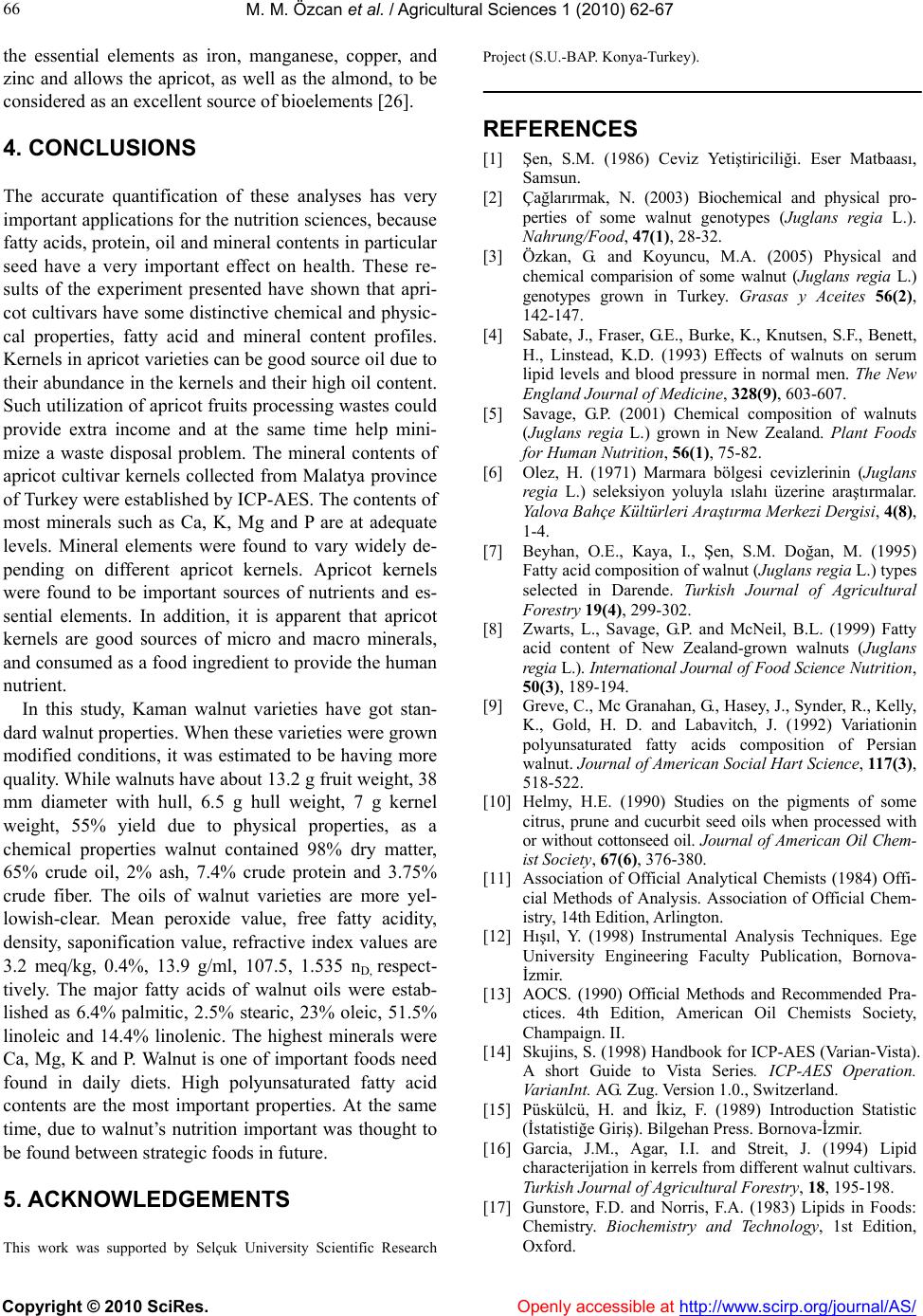
M. M. Özcan et al. / Agricultural Sciences 1 (2010) 62-67
Copyright © 2010 SciRes. Openly accessi ble at http://www.scirp.org/journal/AS/
66
the essential elements as iron, manganese, copper, and
zinc and allows the apricot, as well as the almond, to be
considered as an excellent source of bioelements [26].
4. CONCLUSIONS
The accurate quantification of these analyses has very
important applications for the nutrition sciences, because
fatty acids, protein, oil and mineral contents in particular
seed have a very important effect on health. These re-
sults of the experiment presented have shown that apri-
cot cultivars have some distinctive chemical and physic-
cal properties, fatty acid and mineral content profiles.
Kernels in apricot varieties can be good source oil due to
their abundance in the kernels and their high oil content.
Such utilization of apricot fruits processing wastes could
provide extra income and at the same time help mini-
mize a waste disposal problem. The mineral contents of
apricot cultivar kernels collected from Malatya province
of Turkey were established by ICP-AES. The contents of
most minerals such as Ca, K, Mg and P are at adequate
levels. Mineral elements were found to vary widely de-
pending on different apricot kernels. Apricot kernels
were found to be important sources of nutrients and es-
sential elements. In addition, it is apparent that apricot
kernels are good sources of micro and macro minerals,
and consumed as a food ingredient to provide the human
nutrient.
In this study, Kaman walnut varieties have got stan-
dard walnut properties. When these varieties were grown
modified conditions, it was estimated to be having more
quality. While walnuts have about 13.2 g fruit weight, 38
mm diameter with hull, 6.5 g hull weight, 7 g kernel
weight, 55% yield due to physical properties, as a
chemical properties walnut contained 98% dry matter,
65% crude oil, 2% ash, 7.4% crude protein and 3.75%
crude fiber. The oils of walnut varieties are more yel-
lowish-clear. Mean peroxide value, free fatty acidity,
density, saponification value, refractive index values are
3.2 meq/kg, 0.4%, 13.9 g/ml, 107.5, 1.535 nD, respect-
tively. The major fatty acids of walnut oils were estab-
lished as 6.4% palmitic, 2.5% stearic, 23% oleic, 51.5%
linoleic and 14.4% linolenic. The highest minerals were
Ca, Mg, K and P. Walnut is one of important foods need
found in daily diets. High polyunsaturated fatty acid
contents are the most important properties. At the same
time, due to walnut’s nutrition important was thought to
be found between strategic foods in future.
5. ACKNOWLEDGEMENTS
This work was supported by Selçuk University Scientific Research
Project (S.U.-BAP. Konya-Turkey).
REFERENCES
[1] Şen, S.M. (1986) Ceviz Yetiştiriciliği. Eser Matbaası,
Samsun.
[2] Çağlarırmak, N. (2003) Biochemical and physical pro-
perties of some walnut genotypes (Juglans regia L.).
Nahrung/Food, 47(1), 28-32.
[3] Özkan, G. and Koyuncu, M.A. (2005) Physical and
chemical comparision of some walnut (Juglans regia L.)
genotypes grown in Turkey. Grasas y Aceites 56(2),
142-147.
[4] Sabate, J., Fraser, G.E., Burke, K., Knutsen, S.F., Benett,
H., Linstead, K.D. (1993) Effects of walnuts on serum
lipid levels and blood pressure in normal men. The New
England Journal of Medicine, 328(9), 603-607.
[5] Savage, G.P. (2001) Chemical composition of walnuts
(Juglans regia L.) grown in New Zealand. Plant Foods
for Human Nutrition, 56(1), 75-82.
[6] Olez, H. (1971) Marmara bölgesi cevizlerinin (Juglans
regia L.) seleksiyon yoluyla ıslahı üzerine araştırmalar.
Yalova Bahçe Kültürleri Araştırma Merkezi Dergisi, 4(8),
1-4.
[7] Beyhan, O.E., Kaya, I., Şen, S.M. Doğan, M. (1995)
Fatty acid composition of walnut (Juglans regia L.) types
selected in Darende. Turkish Journal of Agricultural
Forestry 19(4), 299-302.
[8] Zwarts, L., Savage, G.P. and McNeil, B.L. (1999) Fatty
acid content of New Zealand-grown walnuts (Juglans
regi a L.). International Journal of Food Science Nutrition,
50(3), 189-194.
[9] Greve, C., Mc Granahan, G., Hasey, J., Synder, R., Kelly,
K., Gold, H. D. and Labavitch, J. (1992) Variationin
polyunsaturated fatty acids composition of Persian
walnut. Journal of American Social Hart Science, 117(3),
518-522.
[10] Helmy, H.E. (1990) Studies on the pigments of some
citrus, prune and cucurbit seed oils when processed with
or without cottonseed oil. Journal of American Oil Chem-
ist Society, 67(6), 376-380.
[11] Association of Official Analytical Chemists (1984) Offi-
cial Methods of Analysis. Association of Official Chem-
istry, 14th Edition, Arlington.
[12] Hışıl, Y. (1998) Instrumental Analysis Techniques. Ege
University Engineering Faculty Publication, Bornova-
İzmir.
[13] AOCS. (1990) Official Methods and Recommended Pra-
ctices. 4th Edition, American Oil Chemists Society,
Champaign. II.
[14] Skujins, S. (1998) Handbook for ICP-AES (Varian-Vista).
A short Guide to Vista Series. ICP-AES Operation.
VarianInt. AG. Zug. Version 1.0., Switzerland.
[15] Püskülcü, H. and İkiz, F. (1989) Introduction Statistic
(İstatistiğe Giriş). Bilgehan Press. Bornova-İzmir.
[16] Garcia, J.M., Agar, I.I. and Streit, J. (1994) Lipid
characterijation in kerrels from different walnut cultivars.
Turkish Journal of Agricultural Forestry, 18, 195-198.
[17] Gunstore, F.D. and Norris, F.A. (1983) Lipids in Foods:
Chemistry. Biochemistry and Technology, 1st Edition,
Oxford.